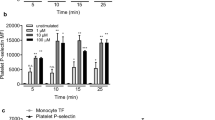Abstract
The circulating monocyte exhibits the capacity to initiate and accelerate the coagulation cascade. We have devised a simple whole blood clotting assay which quantitates the monocyte's contribution of procoagulant (a marker of monocyte activation) to the clotting process and in addition, measures thein vivo activation of the cell. Citrated whole blood is added to saline and the recalcification time (RT) determined without incubation (RT control), with two hours incubation (RT saline), or added to endotoxin with incubation (RT endotoxin). The reduction in value between RT control and RT saline is a measure of monocyte activationin vivo. The reduction, in time between RT saline and RT endotoxin is a marker of monocyte activationin vitro. This simple test enables the measurement of monocyte activation and this cells contribution to the hypercoagulability described in many disease states.
Similar content being viewed by others
References
R. L. Edwards, F. R. Rickles and M. Cronlund,Abnormalities of blood coagulation in patients with cancer. J. Lab. Clin. Med.98, 917–928 (1981).
B. Osterud and E. Bjorklid,The production and availability of tissue thromboplastin in cellular populations of whole blood exposed to various concentrations of endotoxin. Scand. Haematol.29, 175–184 (1982).
C. R. Spillert, C. T. Curtis and E. J. Lazaro,Assessment of monocyte function in the diagnosis of breast disease. South Med J81, 164–166 (1988).
J. N. McCullough, C. R. Spillert and E. J. Lazaro,A direct correlation between injury severity and two markers of the functional status of the immune system. Circ. Shock.31, 309–316 (1990).
C. R. Spillert, J. T. Milazzo, W. D. Suval and E. J. Lazaro,Hypercoagulability in arterial disease. Angiology.40, 886–889 (1989).
C. R. Spillert, V. J. Milazzo, J. A. Pastena and E. J. Lazaro,Prediction of clinical course of diabetes utilizing a simple coagulation test. J. Natl. Med. Assoc.81, 81–83 (1989).
K. S. Dasmahapatra, N. R. Cheung, C. R. Spillert and E. J. Lazaro,An assessment of monocyte procoagulant activity in patients with solid tumors. J. Surg. Res.43, 158–169 (1987).
C. R. Spillert, M. P. Hafstein, V. Lanke and E. J. Lazaro,Increased thromboplastin production in multiple sclerosis: An immunologic defect? Ann. NY Acad. Sci.475, 345–346 (1986).
Author information
Authors and Affiliations
Rights and permissions
About this article
Cite this article
Spillert, C.R., Lazaro, E.J. Contribution of the monocyte to thrombotic potential. Agents and Actions 34, 28–29 (1991). https://doi.org/10.1007/BF01993228
Issue Date:
DOI: https://doi.org/10.1007/BF01993228




